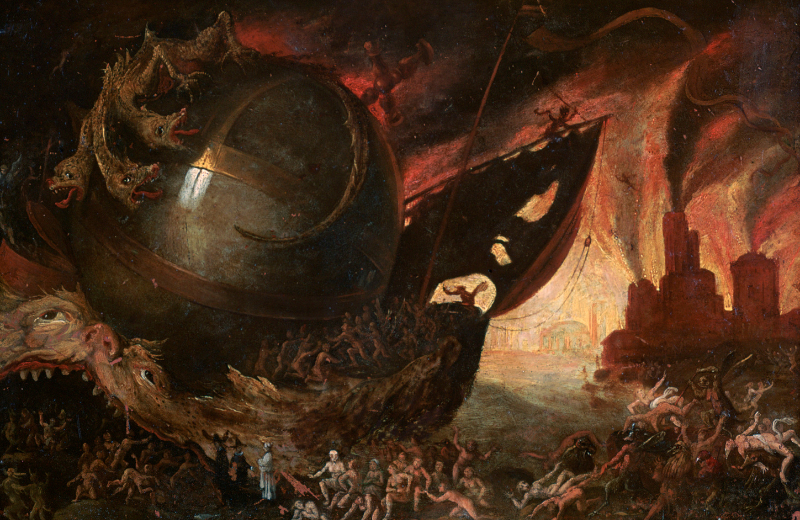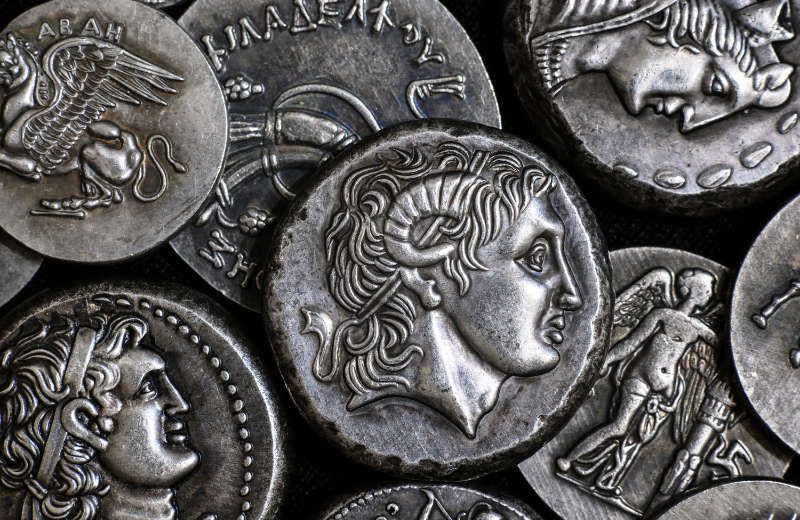Charon, the ferryman of the dead, plays a key part in guiding souls across the River Styx, separating the world of the living from the underworld. Let’s dive into the myths, powers, and symbols surrounding Charon and explore how this ancient figure has left a lasting impact.
Jump to:
- Who is Charon in Greek Mythology?
- What is Charon the God of?
- The Myths and Legends of Charon
- The Symbols of Charon
- What Powers Does Charon Have?
- Charon's Relationships, Children, and Family Tree
- Charon's Worship and Legacy
- Charon's Lasting Impact on Art and Culture
- Frequently Asked Questions About Charon
- Study Greek Mythology for £29
Recommended for you!
Best SellersWho is Charon in Greek Mythology?
Charon, often referred to as the ferryman of the dead, is an Olympian god in Greek mythology. His primary duty is to ferry souls across the rivers that divide the land of the living from the afterlife, particularly the River Styx. To pay for their passage, souls would offer Charon a coin, typically an obol, which was placed in the mouth of the deceased at burial. Without payment, the souls would be doomed to wander the riverbanks for eternity.
Charon’s role in the afterlife makes him a figure of great importance, as he is the one who bridges the gap between life and death. Although not as widely worshipped as other gods, his presence is essential in the journey of souls to the afterlife.
What is Charon the God of?

While Charon is not the god of death itself—this role belongs to Thanatos—he is the god associated with the act of ferrying the dead. His task is sombre but essential, as he ensures that the dead reach their final resting place in the underworld. This realm, ruled by Hades, is a place where the souls of the deceased reside. Charon’s role is to transport the souls across the rivers, primarily the Styx, but also the Acheron in some myths. His job is straightforward: ensure the passage of souls into the afterlife, provided they have the fare.
The Myths and Legends of Charon
Charon plays a central role in several significant myths in Greek mythology. These stories highlight his role in guiding souls to the underworld and demonstrate his strict adherence to his duties.
Heracles and Cerberus
To reach Cerberus, Heracles had to cross the River Styx. Although Charon's role was to ferry only the souls of the dead, he reluctantly allowed Heracles, a living man, to cross. This act was an exception to his usual rule, and for his leniency, Charon was later punished by Hades.
This myth reinforces the idea that Charon’s duties were meant to be followed with strict adherence, making his transgression all the more significant.
Orpheus and Eurydice
Another myth involving Charon is the tragic story of Orpheus and Eurydice. When Orpheus’ wife, Eurydice, died, the grief-stricken musician ventured into the underworld to bring her back. Armed with nothing but his lyre, Orpheus played such moving music that it softened even the heart of Charon.
Moved by the beauty of Orpheus’ music, Charon allowed him to cross the river without the usual payment. This rare moment of compassion reveals a softer, more human side to Charon, who is typically seen as an unyielding figure.
The Ferryman and the River Styx
Charon is closely associated with the River Styx, one of the five rivers of the underworld. The myth of the river itself represents a barrier between life and death, and Charon’s role as the ferryman is essential in guiding souls across.
In this sense, Charon is a gatekeeper between worlds, embodying the transition from life to the afterlife.
The Symbols of Charon

Charon’s role as the ferryman of the dead is represented through various symbols, each reflecting a different aspect of his duties and character. These symbols have appeared in art, literature, and mythology, helping to define his presence in the underworld.
- The Boat: Charon’s most recognised symbol, it represents the vessel he uses to transport souls across the River Styx. This image is iconic and appears in many artistic depictions.
- The Oar: Closely associated with Charon, the oar signifies his control over the journey between life and death, guiding souls to their final destination.
- The Red Cap: In some depictions, Charon is shown wearing a red cap, symbolising his grim duty. It has become a distinct feature of his appearance in certain artworks.
- Gaunt Appearance: Charon is often portrayed as a skeletal or grim figure, representing death and the transition between the living world and the underworld. However, he should not be confused with the Grim Reaper of later mythologies.
What Powers Does Charon Have?
While Charon is not a figure of immense power like Zeus or Poseidon, his abilities are significant within his domain. His power lies in his control over the journey of souls. Without him, the dead cannot cross into the afterlife. This makes Charon a gatekeeper of sorts—someone who determines the fate of souls based on their ability to pay for their passage.
Charon’s power is also rooted in his knowledge of the underworld. He knows the paths across the rivers and is bound by duty to carry out his task. This makes him a figure of endurance and responsibility, whose power is directly tied to his unyielding role as the ferryman.
Charon's Relationships, Children, and Family Tree
Charon’s background and family connections tie him to the darker elements of Greek mythology. However, his focus on duty makes him a solitary figure with few personal relationships.
- Parents: Charon is traditionally the son of Nyx, the primordial goddess of the night, and Erebus, the god of darkness. His lineage emphasises his association with death, darkness, and the night.
- Offspring: In mythology, Charon has no known children or significant relationships, highlighting his dedication to his role as the ferryman of the dead.
- Connection to Hades: Although not directly subordinate to Hades, Charon works within Hades' realm and plays a key role in the underworld by ferrying souls across the River Styx.
Charon's Worship and Legacy

Unlike other gods and goddesses, Charon was not widely worshipped in the same way that deities were. He was more a figure of respect and fear. The act of placing coins in the mouths of the dead as payment for Charon’s services became a ritual, ensuring that loved ones would not be left to wander the riverbanks for eternity.
Charon's Lasting Impact on Art and Culture
Charon has made a significant impact on art, literature, and even popular culture. His image as the ferryman of the dead has appeared in countless paintings, sculptures, and in modern media. In Dante’s Inferno, Charon is featured as the one who ferries souls across the River Acheron into Hell, showing how his image has transcended Greek mythology and entered broader cultural contexts.
His depiction often carries themes of death, transition, and the unknown—all of which resonate with people’s eternal curiosity about what lies beyond.
Recommended for you!
Best SellersFrequently Asked Questions About Charon
Does Charon have a Roman equivalent?
Charon does have a Roman equivalent, also named Charon. In Roman mythology, he is depicted similarly to his Greek counterpart, serving as the ferryman of the dead. The Romans adopted many of the gods and figures from Greek mythology, including Charon, although his role remained largely the same in both cultures.
What does the name "Charon" mean?
The name "Charon" is believed to come from an ancient Greek word that means "fierce brightness" or "glare," possibly referring to his association with death and the grim task of ferrying souls to the underworld. Some interpret this as symbolising the harsh reality of death or the blinding light one might experience at the moment of death.
How is Charon pronounced?
Charon is pronounced KAIR-on, not KARE-en like the common modern name. The pronunciation can vary slightly depending on the language, but in Greek mythology, it is generally pronounced with a hard "K" sound.
What happens if Charon dies?
Charon is an immortal figure in Greek mythology, so the concept of him dying is not part of traditional myths. However, if he were to cease his role, the passage of souls into the underworld would halt, leaving the dead stranded on the banks of the River Styx or Acheron. The dead would be unable to cross into the afterlife without his guidance.
Is Charon associated with any specific colours or clothing?
Charon is often depicted wearing dark or tattered robes, reflecting his connection to death and the underworld. In some artistic representations, he is also shown wearing a red cap, which has become a distinct part of his symbolic imagery.
What is Charon's connection to Pluto's moon?
Pluto's moon, Charon, is named after the mythological ferryman due to its association with the underworld. This connection was chosen to align with Pluto’s name, the Roman counterpart to Hades, ruler of the underworld.
What happens if someone cannot pay Charon?
In Greek mythology, those who cannot pay Charon’s fee are left to wander the shores of the River Styx or Acheron for eternity, unable to cross into the underworld. This highlights the importance of proper burial rites and the coin placed in the mouth of the dead.
Study Greek Mythology for £29
If you're fascinated by Greek myths and the stories of gods, heroes, and legendary figures like Andromeda, why not explore further with the Greek Mythology Diploma Course at Centre of Excellence? For a limited time, you can access this course for just £29 – a brilliant opportunity to enrich your understanding of these timeless tales.













